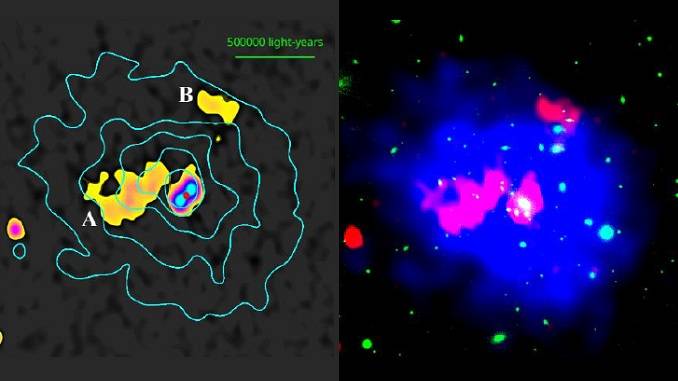
GMRT (Giant Metrewave Radio Telescope) discovers the oldest known fossil radio galaxy trapped inside a cluster of galaxies –
An extremely old remnant of the ‘lobes’ of a once active radio galaxy has recently been discovered by an Indian team of astronomers led by Dr. Surajit Paul of Savitribai Phule Pune University (SPPU) with the help of GMRT. Because of the high sensitivity of the GMRT, the discovery of these “fossil lobes” via their low radio-frequency radiation was made possible.
GMRT (Giant Metrewave Radio Telescope) –
GMRT, that is, ‘Giant Metrewave Radio Telescope’, is located near Khodad village, 80 km north of Pune. The National Centre for Radio Astrophysics (NCRA) of the Tata Institute of Fundamental Research (TIFR) has established and operates this front-ranking radio telescope.
Other telescopes, the Very Large Array (VLA), Low Frequency Array (LoFAR), and Chandra X-ray Observatory, also contributed to this technically challenging study.
Recently, these results have been published in two research articles that appeared in prestigious international journals – Astronomy & Astrophysics (A&A) and in the Publications of the Astronomical Society of Australia (PASA).
In addition to Dr. Surajit Paul, the other researchers included Sameer Salunkhe, Dr. Satish Sonkamble, Shubham Bhagat, and Prof. Gopal Krishna.
The team said that this pair of gigantic lobes of a radio galaxy spanned 1.2 million light-years inside the galaxy cluster Abell 980 and was created about 260 million years ago.

Large galaxies are made up of billions of stars. A lot of them reside in clusters containing 100 to 1000 galaxies that are all connected together by mutual gravity. Additionally, all large galaxies are currently thought to harbor a supermassive black hole (SMBH) at their center, often with a mass equivalent to several million to billions of Suns. These black holes emit two oppositely-directed collimated “jets” of magnetised relativistic plasma when they become “active,” each of which feeds into an expanding lobe that makes it radiate at radio frequencies.
Large radio telescopes can detect such “radio lobes” up to a distance of billions of light-years.
A supermassive black hole’s episode of jet production in a galaxy (called the ‘active’ phase) typically lasts tens of millions of years, after which jet production and hence energy supply into the radio lobes ceases. Then, the two radio lobes rapidly fade away without being detected. In fact, it’s possible that billions of massive galaxies blew out radio lobes during their multiple active phases over the age of the universe and the universe is infested with their faded relics.

Relics or fossil lobes of radio galaxies are also repositories of important information about the circumstances in the bygone era of the universe, just like the fossil records of animals, plants, and terrestrial events. Sadly, the rapid fading of the fossil radio lobes makes it difficult to discover them.
However, the pressure of the surrounding hot gas (which typically permeates galaxy clusters and is detectable with X-ray telescopes) can significantly slow down the expansion and subsequent fading of the radio lobes if the parent galaxy happens to be inside a cluster of galaxies. This external confinement of the radio lobes during their relic stage can greatly extend their detectable lifespan, particularly at meter wavelengths where the radiative losses are quite low.
The galaxy cluster harboring the fossil radio lobes must remain in a dynamically quiescent condition, in order for the lobes to be detectable despite their lengthy lifespan. This is the second crucial criterion for their detection. Luckily, the cluster Abell 980 is in a relaxed state as indicated by its thermal X-ray emission.
According to Dr. Paul and Prof. Gopal Krishna, the GMRT discovery of the two extremely old fossil radio lobes with a record age of nearly 260 million years (a record so far), owes to a combination of these two extraordinarily rare favorable circumstances.
Dr. Paul initiated and has long studied the study of radio-wave emission from the environments within relatively low-mass clusters of galaxies. He believes that low-mass clusters of galaxies, like Abell 980, are uniquely suited for satisfying the requirement of a less disturbed internal environment because their shallow gravitational potential is dominated by at most a few large galaxies.
Double-Double Radio Galaxies” (DDRG)
The jet production activity, which creates a pair of rapidly advancing radio lobes on opposite sides of an active galaxy, is now well established to be episodic nature. In fact, a huge galaxy can go through these “active” phases repeatedly, creating a pair of radio lobes known as a “double radio source” each time. In a sense, the two radio lobe pairs that are visible flanking the parent galaxy in such sources can be viewed as “siblings” that are parented by the same galaxy that is located in their middle. A few dozen examples of such “double-double radio galaxies” (DDRG) have already been discovered.
Prof. Gopal Krishna and colleagues solved the mystery of the ‘missing’ parent galaxy of the two fossil radio lobes stated above by showing that their parent galaxy has drifted away towards the gravitational center of the galaxy cluster during the long lifespan of those fossil radio lobes, thus traversing a distance of 250000 light-years. That galaxy has entered into a new phase of activity on reaching the cluster core, creating a new pair of radio lobes that are both smaller and brighter. Thus, they are the younger siblings of the two fossil radio lobes.
The novel feature of this recently proposed model invoking the motion of the parent galaxy is that the younger pair of radio lobes would not be collinear with the two fossil radio lobes but rather have a huge lateral separation from them. Because of this large positional offset, the pair of younger radio lobes could be easily misconstrued as an independent double radio source unrelated to the fossil lobes.
detached Double-Double Radio Galaxies’ (dDDRGs)
This new morphological type of radio galaxies has been named ‘detached double-double radio galaxies’ (dDDRGs) by Gopal Krishna and colleagues. In the future, highly sensitive radio observations may show more such examples, allowing a deeper investigation into the origin of recurrent jet activity in supermassive black holes at galaxies’ centers.
Source – National Centre for Radio Astrophysics (NCRA-TIFR), Pune, Press Note: GMRT discovers the oldest known fossil radio galaxy trapped inside a cluster of galaxies
Research Team:
1. Dr. Surajit Paul, an Astrophysicist from Savitribai Phule Pune University (SPPU),
2. Sameer Salunkhe is Dr. Paul’s Ph.D. student,
3. Dr. Satish Sonkamble is a postdoc at INAFPadova Astronomical Observatory, Italy,
4. Shubham Bhagat, (an alumni of Dr. Paul’s lab), is a Ph.D. student at TLS, Jena, Germany,
5. Prof. Gopal Krishna is a Senior Scientist of the Indian National Science Academy, working at UM-DAE Centre for Excellence in Basic Sciences (CEBS), Mumbai.
Recently, these results (GMRT discovers the oldest known fossil radio galaxy trapped inside a cluster of galaxies) have been published in two research articles that appeared in the following prestigious international journals –
1. Authored by Sameer Salunkhe et al. (2022) in Astronomy & Astrophysics (A&A) published by EDP Sciences for European Southern Observatory (ESO)
Publication links – https://doi.org/10.1051/0004-6361/202243438 (Salunkhe et al., 2022, A&A, in press)
2. Authored by Gopal Krishna et al. (2022) in the Publications of the Astronomical Society of Australia (PASA) published by Cambridge University Press
Publication links – https://doi.org/10.48550/arXiv.2207.05166 [10.1017/pasa.2022.30](Gopal-Krishna et al., 2022, PASA, in press)
Read Also: Interesting Facts (Short Stories) in Hindi and English about World, Life & Science
Copyrighted Material © 2019 - 2024 Prinsli.com - All rights reserved
All content on this website is copyrighted. It is prohibited to copy, publish or distribute the content and images of this website through any website, book, newspaper, software, videos, YouTube Channel or any other medium without written permission. You are not authorized to alter, obscure or remove any proprietary information, copyright or logo from this Website in any way. If any of these rules are violated, it will be strongly protested and legal action will be taken.





Be the first to comment